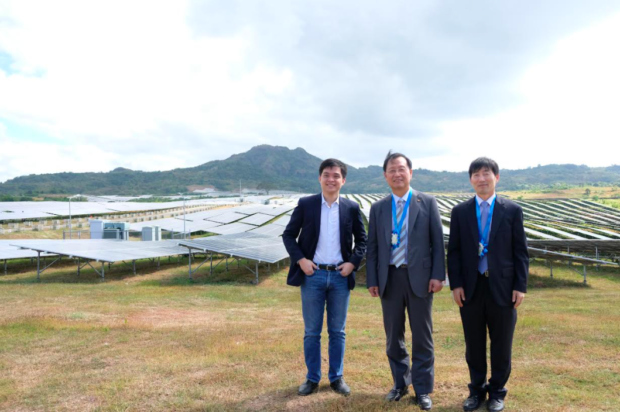
YOUNGEST TO BRING A COMPANY PUBLIC Solar Philippines founder Leandro Leviste (Left) and Kepco CEO Kim Jong-kap (middle) at Calatagan Solar Farm
Leandro Leviste was about to finish his sophomore year as a Political Science major at Yale University in 2013, supposedly heading to Law school, when he took on the challenge of starting a business that would harness the power of the sun to generate electricity. He was just 20 when he set up Solar Philippines.
A year after, Solar inaugurated its first project—a 700-kilowatt solar system on the roof deck of Central Mall Biñan. This was followed by the 2016 commissioning of a 63-megawatt (MW) solar farm near the foot of Mount San Piro in Calatagan, Batangas, which eventually became a partnership with Korea Electric Power Corp. (Kepco).
He went on to build another solar farm in Tarlac, took in the Razon Group as partner, and is now expanding its capacity to 200MW. Two more projects in Batangas and Cavite with a combined capacity of 140MW are targeted to be fully operational by 2022.
But his most ambitious project is a 500-MW solar farm in Nueva Ecija, touted to be the largest in Southeast Asia, with leasing rights covering 352.42 hectares of former pasture land. With a potential to scale up to 1.2 gigawatts, it could even be one of the largest in the world, if everything goes as planned. Solar Philippines Nueva Ecija Corp. (SPNEC), the Solar subsidiary undertaking this massive project, recently obtained the go-ahead from corporate regulators to launch an initial public offering worth as much as P2.7 billion, bringing the first solar pure-play to the local stock market.
This also makes Leviste —now 28 and responsible for an enterprise with more than a thousand employees—the youngest business founder in recent Philippine Stock Exchange (PSE) history to bring a company public.SPNEC is also the first to qualify for the PSE’s decade-old but never-before tested renewable energy (RE) listing rules, which allow RE firms without operating history to launch an IPO as long as they have a valid and subsisting service contract awarded by the Department of Energy, alongside compliance with other requirements.
On Dec. 1 to Dec 7, SPNEC will offer up to 2.7 billion primary common shares at a maximum of P1 per share (pricing will be finalized on Nov. 23), which will bring about a third of SPNEC to public hands. Proceeds will fund construction and development of the first 50MW of the Nueva Ecjja project, the transmission line to connect to the Luzon grid, land lease for 2022, and general corporate purposes.Abacus Capital is the issue manager and lead underwriter, while Investment Capital Corporation of the Philippines is a participating underwriter.
Playing the long game
Some people argue that Leviste is not your ordinary start-up founder as he had the headstart in this entrepreneurial journey. After all, he is the son of Loren Legarda—Deputy House Speaker and Antique Representative, former three-term Senator and a long-time environmental advocate. His father is former Batangas Governor Antonio Leviste. Beyond his formidable family roots, he is a passionate young man with big dreams: make solar the country’s largest source of energy, overtaking coal in terms of installed capacity, by the middle of this decade. “We recognize that we will not get there by seeking to beat the incumbents. We’ll get there when we can convince the incumbents: replace your coal and gas plants with solar. And we’re trying to make it easy for them by making the land available,” Leviste said in a recent Zoom interview with Inquirer.
Solar’s new unit, Solar Energy Zones Inc., has already procured 10,000 hectares of land to be used not for its own projects, but to offer to large power companies looking to develop RE projects, especially with the moratorium on new coal power plants. Because land scarcity is the biggest hurdle to building more solar farms, this land-banking strategy aims to position Solar to be the preferred supplier of sites to the incumbents and their potential partner. Asked how he would ensure that land acquisition for solar won’t affect food security, Leviste said any irrigated land was out of the question. But this business, he believes, is what will bulk up Solar for a larger IPO of its own in the not-so-distant future.
RE ‘pure play’
SPNEC’s first 50MW (phase 1A) is targeted for commissioning in mid-2022, and another 175 MW (phase 1B) by late 2022. Based on its prospectus, SPNEC expects to start getting positive operating cash flows once it switches on phase 1A around late 2022.
After funding its expansion requirements, SPNEC intends to maintain an annual dividend policy equivalent to 10 to 30 percent of the previous fiscal year’s net income after tax.
Asked about the basis for the maximum IPO pricing—which would unlock P8.1 billion in valuation for SPNEC, Leviste said: “The value of SPNEC will come down to whether we can replicate what we did on our past solar projects, like the Calatagan solar farm,” Leviste said.
Solar invested its starting capital in this Batangas solar farm in 2015 and sold a 38-percent stake to Kepco in 2018 for P2.25 billion, giving the farm a valuation of more than P5 billion. Proceeds were used to build the Tarlac solar farm, in which the Razon group invested P1.5 billion to acquire a 50-percent stake in 2020.
The prospectus also states that Solar’s shares in SPNEC have been pledged to AC Energy Corp. (Acen)- presumably in relation to a P1-billion loan the Ayala unit extended in mid-June. The loan covenant allows the prepayment of the loan to Acen, or negotiation for the change in collateral.
“All of the big coal and gas companies are saying that RE is the future. The gap is being bridged, but still, there is a gap and we believe that there will be some milestones that will cause the gap to close. So hopefully, in the near future, we will be able to list the parent (Solar) as well.”

